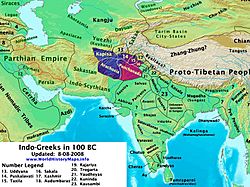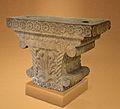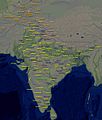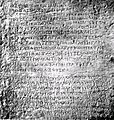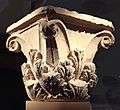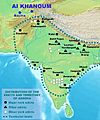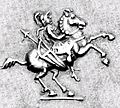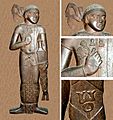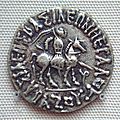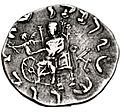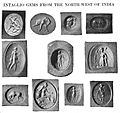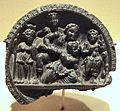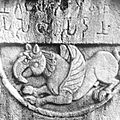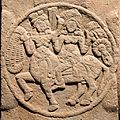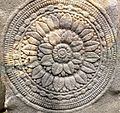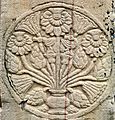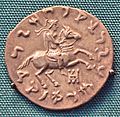Indo-Greek Kingdom facts for kids
The Indo-Greek Kingdom was a part of the Greek Empire. It ruled in parts of northwest and northern Indian subcontinent (present-day Pakistan) from 180 BCE to around 10 CE, and was ruled by a succession of more than thirty Hellenic kings.
Images for kids
-
Pataliputra Palace capital, showing Greek and Persian influence, early Mauryan Empire period, 3rd century BC.
-
Kandahar Bilingual Rock Inscription (Greek and Aramaic) by king Ashoka, from Kandahar, Afghanistan.
-
According to the Mahavamsa, the Great Stupa in Anuradhapura, Sri Lanka, was dedicated by a 30,000-strong "Yona" (Greek) delegation from "Alexandria" around 130 BC.
-
Greco-Bactrian statue of an old man or philosopher, Ai Khanoum, Bactria, 2nd century BC
-
Corinthian capital, found at Ai-Khanoum, 2nd century BC
-
Coin depicting the Greco-Bactrian king Euthydemus 230–200 BC. The Greek inscription reads: ΒΑΣΙΛΕΩΣ ΕΥΘΥΔΗΜΟΥ – "(of) King Euthydemus".
-
Greco-Bactria and the city of Ai-Khanoum were located at the very doorstep of Mauryan India.
-
Silver coin depicting Demetrius I of Bactria (reigned c. 200–180 BC), wearing an elephant scalp, symbol of his conquests of areas in what is now Afghanistan and Pakistan.
-
The coinage of Agathocles (circa 180 BC) incorporated the Brahmi script and several deities from India, which have been variously interpreted as Vishnu, Shiva, Vasudeva, Balarama or the Buddha.
-
Menander I (155–130 BC) is one of the few Indo-Greek kings mentioned in both Graeco-Roman and Indian sources.
-
Indian-standard coinage of Menander I with wheel design. Obv ΒΑΣΙΛΕΩΣ ΣΩΤΗΡΟΣ ΜΕΝΑΝΔΡΟΥ "Of Saviour King Menander" around wheel. Rev Palm of victory, Kharoshthi legend Māhārajasa trātadasa Menandrāsa, British Museum.
-
The Yavanarajya inscription discovered in Mathura, mentions its carving on "The last day of year 116 of Yavana hegemony" (Yavanarajya), or 116th year if the Yavana era, suggesting the Greeks ruled over Mathura as late as 60 BC. Mathura Museum.
-
Heliocles (145–130 BC) was the last Greek king in Bactria.
-
The Heliodorus pillar, commissioned by Indo-Greek ambassador Heliodorus, is the first known inscription related to Vaishnavism in India. Heliodurus was one of the earliest recorded Indo-Greek converts to Hinduism.
-
Foreigners on the Northern Gateway of Stupa I at Sanchi.
-
Hermaeus posthumous issue struck by Indo-Scythians near Kabul, circa 80–75 BC.
-
Tetradrachm of Hippostratos, reigned circa 65–55 BC, was the last Indo-Greek king in Western Punjab.
-
Hippostratos was replaced by the Indo-Scythian king Azes I (r. c. 35–12 BC).
-
Approximate region of East Punjab and Strato II's capital Sagala.
-
The last known Indo-Greek kings Strato II and Strato III, here on a joint coin (25 BC-10 AD), were the last Indo-Greek king in eastern territories of Eastern Punjab.
-
Evolution of Zeus Nikephoros ("Zeus holding Nike") on Indo-Greek coinage: from the Classical motif of Nike handing the wreath of victory to Zeus himself (left, coin of Heliocles I 145–130 BC), then to a baby elephant (middle, coin of Antialcidas 115–95 BC), and then to the Wheel of the Law, symbol of Buddhism (right, coin of Menander II 90–85 BC).
-
Indo-Corinthian capital representing a man wearing a Graeco-Roman-style coat with fibula, and making a blessing gesture. Butkara Stupa, National Museum of Oriental Art, Rome.
-
Indian-standard coinage of Menander I. Obv ΒΑΣΙΛΕΩΣ ΣΩΤΗΡΟΣ ΜΕΝΑΝΔΡΟΥ "Of Saviour King Menander". Rev Palm of victory, Kharoshthi legend Māhārajasa trātadasa Menandrāsa, British Museum.
-
Greek Buddhist devotees, holding plantain leaves, in purely Hellenistic style, inside Corinthian columns, Buner relief, Victoria and Albert Museum.
-
Seated Buddha, Gandhara, 2nd century (Ostasiatisches Museum, Berlin)
-
Cupro-nickel coins of king Pantaleon point to a Chinese origin of the metal.
-
Athena in the art of Gandhara, displayed at the Lahore Museum, Pakistan
-
The Indo-Scythian Taxila copper plate uses the Macedonian month of "Panemos" for calendrical purposes (British Museum).
-
Hellenistic couple from Taxila (Guimet Museum)
-
The story of the Trojan horse was depicted in the art of Gandhara. (British Museum).
-
Female riding a Centaur.
See also
 In Spanish: Reino indogriego para niños
In Spanish: Reino indogriego para niños


